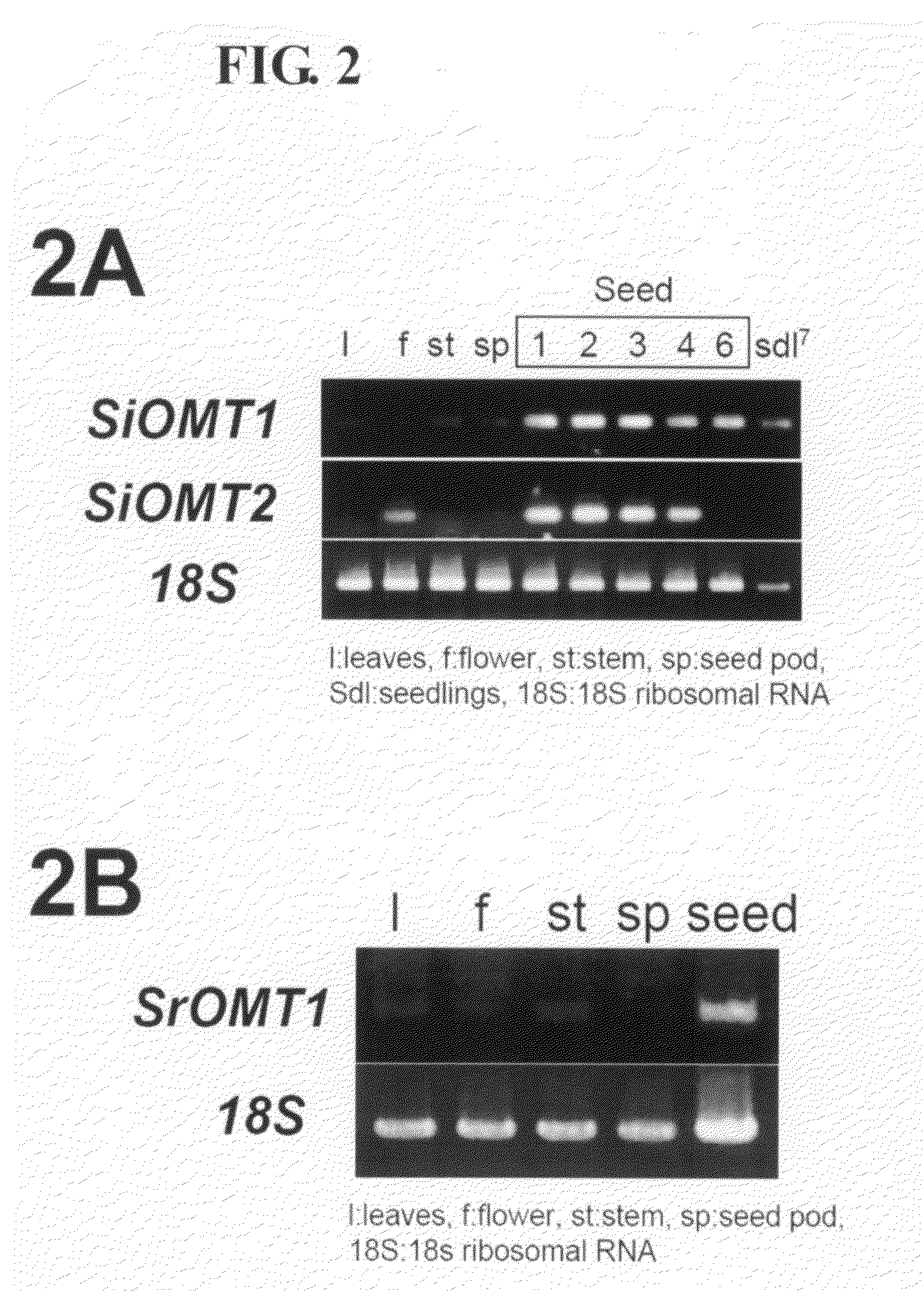Gene encoding lignan methylation enzyme
a technology of methylation enzyme and gene, which is applied in the field of genes for enzymes, can solve the problems of limited information on the genes involved in the biosynthesis of lignans, especially furofuran type lignans as typified by sesame lignans, and achieve the effect of increasing the amount of lignans
- Summary
- Abstract
- Description
- Claims
- Application Information
AI Technical Summary
Benefits of technology
Problems solved by technology
Method used
Image
Examples
example 1
EST Analysis of Sesame Seed
[0155]In the sesame seed-derived cDNA library described in a known literature (WO 2005 / 030944), pBK-CMV phagemid (Stratagene) was excised using the Rapid Excision Kit (Stratagene) according to the protocol recommended by the manufacturer, and infected into Escherichia coli. From the Escherichia coli colonies containing this sesame seed-derived ES, 5000 clones were picked up at random, and colony PCR was performed under the following conditions using M13RV primer (SEQ ID NO: 5) and M4 (−20) primer (SEQ ID NO: 6). The Escherichia coli colony was suspended in a mixture of 1× Ex-Taq buffer (TaKaRa), 0.2 mM dNTPs, 0.2 pmol / μl of each primer and 1.25U Ex-Taq polymerase, and PCR amplification was performed, after 5 minutes at 94° C., using 30 cycles of 1 minute at 94° C., 1 minute at 55° C. and 2 minutes at 72° C., followed by maintaining at 72° C. for 7 minutes.
[0156]
SEQ ID NO: 5: M13RV: 5′-CAGGAAACAGCATTGACSEQ ID NO: 6: M4-20: 5′-GTAAAACGACGGCCAGT
[0157]These PC...
example 2
Expression Analysis of Sesame Methyltransferase Genes
[0159]To analyze expression patterns of the two genes SiOMT1 and SiOMT2 obtained by the EST analysis, RT-PCR was carried out on cDNA in each part of sesame described in a known literature (WO 2005 / 030944) under the following conditions.
[0160]The solution for PCR is composed of 1 μl of cDNA, 1× Ex-Taq buffer (TaKaRa), 0.2 mM dNTPs, 0.2 pmol / μl of each primer and 1.25 U Ex-Taq polymerase. PCR amplification was performed, after 5 minutes at 94° C., using 32 cycles of 1 minute at 94° C., 1 minute at 55° C. and 2 minutes at 72° C., followed by maintaining at 72° C. for 5 minutes. SiOMT1-FW (SEQ ID NO: 7) and SiOMT1-RV (SEQ ID NO: 8) as well as SiOMT2-FW (SEQ ID NO: 9) and SiOMT2-RV (SEQ ID NO: 10) were used as SiOMT1- and SiOMT2-specific primers. For comparing the SiOMT genes and the endogenous genes in the expression level, PCR was performed simultaneously on an internal standard gene. Specifically, PCR was carried out on sesame 18S r...
example 3
Cloning of Sesame Methyltransferase Genes
[0163]Since the both EST clones did not contain the 5′ end of putative ORF, the 5′ regions of respective SiOMT genes were amplified using the 5′ rapid amplification of cDNA end (hereinafter 5′ RACE) method. Specifically, each of the 5′ regions was amplified using the following primers (SEQ ID NOS: 13-16) with GeneRacer kit (Invitrogen) according to the protocol recommended by the manufacturer.
[0164]
SEQ ID NO: 13: GR-SiOMT1-RV:5′-ccggcccactgttcgggtcctaacgggaaaSEQ ID NO: 14: SiOMT1-NEST-RV:5′-gcaaatccacttcataaaaatSEQ ID NO: 15: GR-SiOMT2-RV:5′-cctcgggttccgctctttctgctcccagaaSEQ ID NO: 16: SiOMT2-NEST-RV:5′-atcaatttgggaaattacaaa
[0165]In SiOMT2, the EST clones did not contain the 3′ end of the putative ORF. Accordingly, 3′ RACE was performed using the primers of SEQ ID NOS: 17 and 18.
[0166]
SEQ ID NO: 17: GR-SiOMT2-FW:5′-gaagatcgccccatgagcatgaaaccctttSEQ ID NO: 18: SiOMT2-NEST-FW:5′-aacgtcgttctgggagcagaaaga
[0167]The nucleotide sequences of the ampl...
PUM
| Property | Measurement | Unit |
|---|---|---|
| temperature | aaaaa | aaaaa |
| pH | aaaaa | aaaaa |
| pressure | aaaaa | aaaaa |
Abstract
Description
Claims
Application Information
 Login to View More
Login to View More - R&D
- Intellectual Property
- Life Sciences
- Materials
- Tech Scout
- Unparalleled Data Quality
- Higher Quality Content
- 60% Fewer Hallucinations
Browse by: Latest US Patents, China's latest patents, Technical Efficacy Thesaurus, Application Domain, Technology Topic, Popular Technical Reports.
© 2025 PatSnap. All rights reserved.Legal|Privacy policy|Modern Slavery Act Transparency Statement|Sitemap|About US| Contact US: help@patsnap.com



